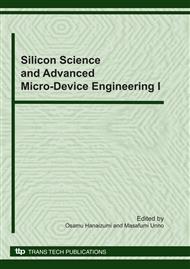[1]
D. F. Kimball, J. Jeong High-Efficiency Envelope-Tracking W-CDMA Base-Station Amplifier Using GaN HFETs, IEEE Trans. on Microwave Theory and Techniques, vol. 54, no. 11 (Nov. 2006).
DOI: 10.1109/tmtt.2006.884685
Google Scholar
[2]
F. Wang, High Efficiency Linear Envelope Tracking and Envelope Elimination and Restoration Power Amplifier for WLAN OFDM Applications, Ph.D. Dissertation, University of California, San Diego (2006).
Google Scholar
[3]
P. Asbeck, D. Kimball, Next Generation High-Efficiency RF Transmitter Technology for Base stations, Extended Abstracts of 2007 International Conference on Solid State Devices and Materials, pp.146-147, Tsukuba (Sept. 2007).
DOI: 10.7567/ssdm.2007.g-1-1
Google Scholar
[4]
P. Draxler, S. Lanfranco, et. al., High Efficiency Envelope Tracking LDMOS Power Amplifier for W-CDMA, IEEE MTT-S International Microwave Symposium, pp.1534-1537 (June 2006).
DOI: 10.1109/mwsym.2006.249605
Google Scholar
[5]
S. C. Cripps, RF Power Amplifier for Wireless Communications, Artec House (1999).
Google Scholar
[6]
S. C. Cripps, Advanced Techniques in RF Power Amplifier Design, Artec House (2002).
Google Scholar
[7]
A. Kanbe, M. Kaneta, H. Kobayashi, H. Yui, YUI, N. Takai, H. Hirata, T. Shimura, K. Yamagishi, New Architecture of Envelope Tracking Power Amplifier for Base Station, IEEE Asia Pacific Conference on Circuits and Systems, Macao, China, pp.296-299, Dec. (2008).
DOI: 10.1109/apccas.2008.4746018
Google Scholar
[8]
B. Bakkaloglu, C. Chu, S. Kiaei, A 10MHz Bandwidth 2mV Ripple PA Supply Regulator for CDMA Transmitters, ISSCC, pp.448-449 (Feb, 2008).
DOI: 10.1109/isscc.2008.4523250
Google Scholar
[9]
J. Lopez, Y. Li, J. D. Popp, D. Y.C. Lie, Ch. -Ch. Chuang, K. Chen, S. Wu, T. -Y. Yang, G. -K. Ma Design of Highly Efficient Wideband RF Polar Transmitters Using the Envelope-Tracking Technique, IEEE Journal of Solid-State Circuits, vol. 44, no. 9, (Sept. 2009). Fig. 1. High efficiency techniques for power amplifiers Fig. 2. Envelope-tracking power supply. Fig. 3. W-CDMA envelope power spectrum.
DOI: 10.1109/jssc.2009.2022669
Google Scholar
[2]
Fig. 4. Conventional envelope tracking power supply circuit.
Google Scholar
[1]
Fig. 5. Operation of conventional circuit in Fig. 4 at initial state. Fig. 6. Steady-state operation of conventional circuit in Fig. 4. Fig. 7. Switching frequency with respect to h and L. Fig. 8. Simulation results for Fig. 4 where the envelope signal is a DC signal. Fig. 9. Simulation results for Fig. 4 where the envelope signal is a sine wave signal. Fig. 10. In the case that the input slope surpasses the slope of DC-DC converter output. Fig. 11. Proposed envelope-tracking circuit. Fig. 12. Switching method in the proposed circuit. Fig. 13. Operation waveforms when the input slew rate is low. Fig. 14. Operation waveforms when the input slew rate is high. Fig. 15. Input envelope signal used for simulation. Fig. 16. Simulation results for Fig. 11 where the input slew rate is varying as in Fig. 15. Fig. 17. Envelope-tracking power supply using DC-DC converter with PWM signal. Fig. 18. Current and PWM signal waveforms in Fig. 17. Fig. 19. Proposed multi-phase architecture. Fig. 20 Simulated current and PWM signal waveforms for Fig. 19. Fig. 21 Comparison of OpAmp currents in the single-phase and multi-phase architectures.
Google Scholar


